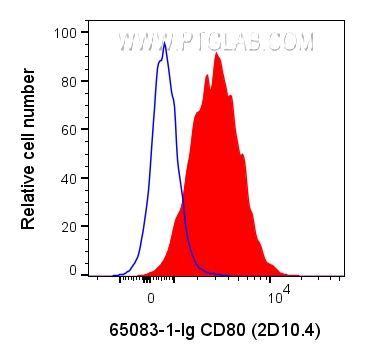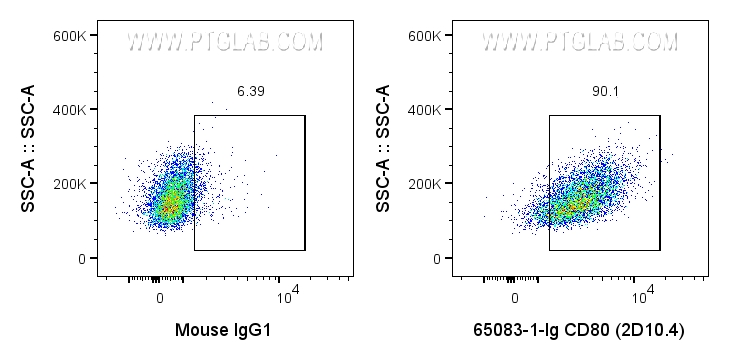验证数据展示
经过测试的应用
| Positive FC detected in | Daudi cells |
推荐稀释比
| 应用 | 推荐稀释比 |
|---|---|
| Flow Cytometry (FC) | FC : 0.2 ug per 10^6 cells in 100 μl suspension |
| This reagent has been tested for flow cytometric analysis. It is recommended that this reagent should be titrated in each testing system to obtain optimal results. | |
| Sample-dependent, Check data in validation data gallery. | |
发表文章中的应用
| FC | See 1 publications below |
产品信息
65083-1-Ig targets CD80 in FC applications and shows reactivity with human samples.
| 经测试应用 | FC Application Description |
| 文献引用应用 | FC |
| 经测试反应性 | human |
| 文献引用反应性 | human |
| 免疫原 |
N/A 种属同源性预测 |
| 宿主/亚型 | Mouse / IgG1, kappa |
| 抗体类别 | Monoclonal |
| 产品类型 | Antibody |
| 全称 | CD80 molecule |
| 别名 | 2D10.4, Activation B7 1 antigen, Activation B7-1 antigen, B7, B7 1 |
| 计算分子量 | 33 kDa |
| GenBank蛋白编号 | BC042665 |
| 基因名称 | CD80 |
| Gene ID (NCBI) | 941 |
| RRID | AB_2918386 |
| 偶联类型 | Unconjugated |
| 形式 | Liquid |
| 纯化方式 | Affinity purification |
| UNIPROT ID | P33681 |
| 储存缓冲液 | PBS with 0.09% sodium azide, pH 7.3. |
| 储存条件 | Store at 2-8°C. Stable for one year after shipment. |
背景介绍
CD80 (also known as B7-1) is a type I membrane protein that is a member of the immunoglobulin superfamily, with an extracellular immunoglobulin constant-like domain and a variable-like domain required for receptor binding. It is expressed on antigen-presenting cells (APCs), including B cells, dendritic cells, monocytes, and macrophages. CD80 is the receptor for the proteins CD28 and CTLA-4 found on the surface of T-cells. It is involved in the costimulatory signal essential for T-lymphocyte activation. T-cell proliferation and cytokine production is induced by the binding of CD28, binding to CTLA-4 has opposite effects and inhibits T-cell activation. CD80 also acts as a cellular attachment receptor for adenovirus subgroup B. (PMID: 7545666; 12015893; 16920215)
实验方案
| Product Specific Protocols | |
|---|---|
| FC protocol for CD80 antibody 65083-1-Ig | Download protocol |
| Standard Protocols | |
|---|---|
| Click here to view our Standard Protocols |



